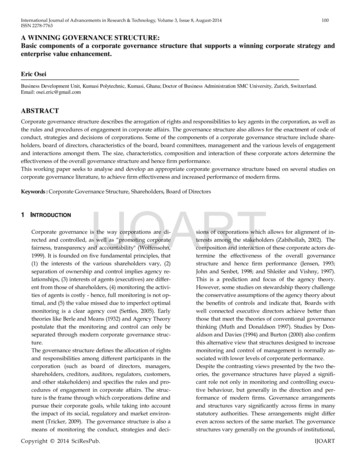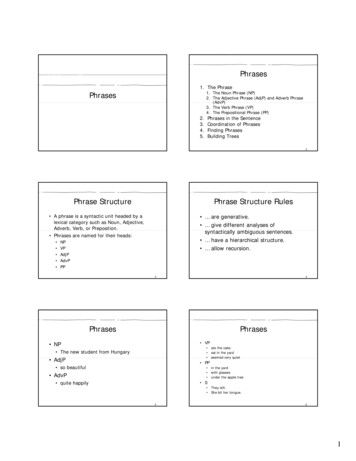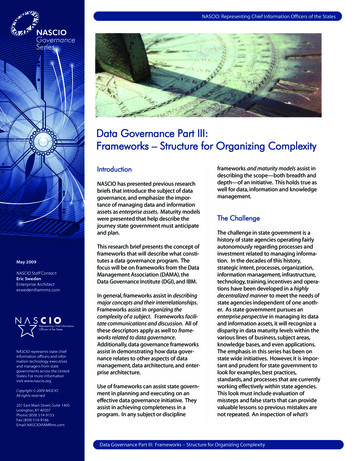
Transcription
International Journal of Advancements in Research & Technology, Volume 3, Issue 8, August-2014ISSN 2278-7763100A WINNING GOVERNANCE STRUCTURE:Basic components of a corporate governance structure that supports a winning corporate strategy andenterprise value enhancement.Eric OseiBusiness Development Unit, Kumasi Polytechnic, Kumasi, Ghana; Doctor of Business Administration SMC University, Zurich, Switzerland.Email: osei.eric@gmail.comABSTRACTCorporate governance structure describes the arrogation of rights and responsibilities to key agents in the corporation, as well asthe rules and procedures of engagement in corporate affairs. The governance structure also allows for the enactment of code ofconduct, strategies and decisions of corporations. Some of the components of a corporate governance structure include shareholders, board of directors, characteristics of the board, board committees, management and the various levels of engagementand interactions amongst them. The size, characteristics, composition and interaction of these corporate actors determine theeffectiveness of the overall governance structure and hence firm performance.This working paper seeks to analyse and develop an appropriate corporate governance structure based on several studies oncorporate governance literature, to achieve firm effectiveness and increased performance of modern firms.Keywords : Corporate Governance Structure, Shareholders, Board of Directors1 INTRODUCTIONIJOARTCorporate governance is the way corporations are directed and controlled, as well as “promoting corporatefairness, transparency and accountability" (Wolfensohn,1999). It is founded on five fundamental principles, that(1) the interests of the various shareholders vary, (2)separation of ownership and control implies agency relationships, (3) interests of agents (executives) are different from those of shareholders, (4) monitoring the activities of agents is costly - hence, full monitoring is not optimal, and (5) the value missed due to imperfect optimalmonitoring is a clear agency cost (Settles, 2005). Earlytheories like Berle and Means (1932) and Agency Theorypostulate that the monitoring and control can only beseparated through modern corporate governance structure.The governance structure defines the allocation of rightsand responsibilities among different participants in thecorporation (such as board of directors, managers,shareholders, creditors, auditors, regulators, customers,and other stakeholders) and specifies the rules and procedures of engagement in corporate affairs. The structure is the frame through which corporations define andpursue their corporate goals, while taking into accountthe impact of its social, regulatory and market environment (Tricker, 2009). The governance structure is also ameans of monitoring the conduct, strategies and deciCopyright 2014 SciResPub.sions of corporations which allows for alignment of interests among the stakeholders (Zabihollah, 2002). Thecomposition and interaction of these corporate actors determine the effectiveness of the overall governancestructure and hence firm performance (Jensen, 1993;John and Senbet, 1998; and Shleifer and Vishny, 1997).This is a prediction and focus of the agency theory.However, some studies on stewardship theory challengethe conservative assumptions of the agency theory aboutthe benefits of controls and indicate that, Boards withwell connected executive directors achieve better thanthose that meet the theories of conventional governancethinking (Muth and Donaldson 1997). Studies by Donaldson and Davies (1994) and Burton (2000) also confirmthis alternative view that structures designed to increasemonitoring and control of management is normally associated with lower levels of corporate performance.Despite the contrasting views presented by the two theories, the governance structures have played a significant role not only in monitoring and controlling executive behaviour, but generally in the direction and performance of modern firms. Governance arrangementsand structures vary significantly across firms in manystatutory authorities. These arrangements might differeven across sectors of the same market. The governancestructures vary generally on the grounds of institutional,IJOART
International Journal of Advancements in Research & Technology, Volume 3, Issue 8, August-2014ISSN 2278-7763political and social traditions (Nestor and Thompson,2008). Consequently, corporate governance structuresmust be developed in the context of the firm to achievethe needed organisational outcomes. This working paper proposes a generic but efficient structure based onthe governance model in figure 1. The figure 1 below isa governance model based on the work by several researchers who have examined different corporate governance structures and their impact on firm value andperformance in different rOversightBoard ofDirectorsBoard CommitteesCompensationAdvisoryCommitteeNomination AdvisoryCommitteeSafety, Health& SustainableDev. CommitteeFigure 1: Governance Model101BusinessEthics & CSRCommitteeAuditCommitteeParty PoliticsDonationCommitteeANNUAL GENERAL MEETINGS (AGMs)ManagementShareholderTypesShareholder Roles& ResponsibilitiesOversight ResponsibilitiesBoard egulationsCommitteeCorporate OfficersInfo. SecurityCommitteeDivisions andGroup CompaniesInternal AuditDivisionManagement Review& SupportDepartmentSource: Researcher’s own construct; adapted from Seatles (2005)IJOARTReporting andCommunicationTechnologySource: Researcher’s Own Construct2.Chief ExecutiveOfficerBoardCommitteesManagement ResponsibilitiesPolicies andProceduresExecutiveCommitteeCORPORATE GOVERNANCE STRUCTUREThe figure 2 below describes the winning corporate governance structure based on an extensive research and experienceover the years. It shows the various components of the governance structure and their relationships for an efficient corporate performance and value creation. It is worth notingthat, the generic corporate governance structure has beendeveloped in the context of an African country or any of theemerging economies.Figure 2: A winning corporate governance structureCopyright 2014 SciResPub.2.1 Shareholders and Shareholders’ MeetingShareholders are individual, company or other institutioninvestors who own at least a share in the company. Theyare the company’s owners, and therefore have a legitimate interest and stake in the governance of their corporations. They have become increasingly diverse within acomplex and challenging markets, as well as the businessand social environment, and are mandated by law toconvene Annual General Meeting (AGM); the highest decision-making body of any company, to exercise theirgovernance rights by voting to influence operational decisions of the company.The primary role of shareholders in a typical efficientcorporate governance model is to elect (with cumulativevoting) directors who are fit, proper and capable of directing management in the best interests of the companyand its shareholders (NACD, 2009) and dismiss directorswhere appropriate. Shareholders should receive sufficient information (e.g. identity, age & background, workexperience, nature of relationship with company & itspartners, financial status) to determine the ability of Supervisory Board nominees to fulfill their duties and, ifapplicable, to ascertain their independence. They are alsorequired to monitor the board’s activities and hold directors accountable for the fulfilment of their duties. Theymay also decide to become board members to improvetheir ability to monitor effectively, but in some jurisdicIJOART
International Journal of Advancements in Research & Technology, Volume 3, Issue 8, August-2014ISSN 2278-7763tions and companies, the law does not permit them to dothat, for example, financial institutions. At the AGM, theshareholders appoint Statutory Auditor as a regulatoryrequirement and for efficient corporate governance. Theyshould be responsible for auditing the accuracy of thecompany’s financial records. Moreover, every corporation should have a formal policy that describes the rightsof voters and corporate actions which needs shareholderapproval. Again, shareholder approval of takeovers,mergers, and buyouts should be required.2.2 Board of Directors (BoD)2.2.1 Board Member CharacteristicsPersons with “full dispositive capacity” should be directors.The members of the board should comprise executive directors, non-executive directors and independent directors. Theexecutive directors are those that hold an executive positionin the company, namely the General Director, ExecutiveBoard member or manager of the company who is not anExecutive Board member. Non-Executive Directors are Supervisory Board members that do not hold any executiveposition in the company. Independent Directors should bean individual who has not been in any of the following positions at the time of the approval of a business transaction, orduring one year immediately preceding the approval of sucha transaction: The General Director, the External Manager,an Executive Board member or a member of the governingbodies (Supervisory Board, General Director and ExecutiveBoard) of the External Manager; or a person with a familylinkage with the External Manager; or an affiliated personother than a director of the company. In addition to theabove, the directors should (a) have a wide range of skills,especially financial literacy (Chhaochharia and Grinstein,2007), (b) be properly remunerated for better supervision(Becher et al 2005; Yermack, 2004) and (c) have long tenurewhich is a function of great experience and knowledge aboutthe firm and its environment (Vafeas, 2003).102as well as ensures effective planning of firm’s activities. Self-appraisal and renewal: The board should continuously evaluate the firm’s activities in comparison with itscompetitors, access and responds to both domestic and external threats.Governance structures and practices should be so designed to position the board to fulfil its duties effectively andefficiently. However, the effectiveness with which the boardperforms its management fiduciary and control functionsmay vary across boards as a result of different board structures, board processes and board committees.2.3. Board StructureThe board structure involves board size, composition, leadership and the information between board structures (Maassen 1999). Though studies (Yermack, 1996 and Eisenberg etal, 1998) have shown no positive relationship between boardsize and corporate performance, others (Zajack 2001) alsosuggest that the size of the board of any corporate governance structure matters. Whilst larger boards are more difficult to coordinate, and may have communication and organisation problems (Forbes and Milliken 1999), a small boardsize experiences efficiency problems. In most modern corporations, the size of the boards varies from seven to elevendirectors, with an average of about nine directors (Gillan,Hartzell & Starks, 2007). Some studies (Seatles, 2005) also tiethe minimum number of directors to the number of shareholders with voting rights, for example, there should be leastfive directors for companies with 1,000 and fewer shareholders with voting rights and at least nine directors for companies with more than 10,000 shareholders with voting rights.According to Zahra and Pearce (1989), the decision on anideal board size should be based on significant environment,strategic and performance factors. Weil, Gotshal and MangesLLP (2012) proposes the nature, size and complexity of corporation, as well needs stage of development should informdecision on the size of the board. Generally for most of thefirms, board size ranges from seven to eleven directors, withan average of about nine directors, so ideally the board sizeof a winning corporate structure should be the average nine,according to Boone et al (2005).The board composition specifies the different kinds of directors put together to form the board. IFF (2002) suggeststhat as a best practice at least 1/3 of the board should benon-executive, majority of whom should be independent.Studies confirm that a greater representation of outsideboard members (i.e. non-executive directors) is a key criterion for board’s effectiveness, control and strategic functions(Byrd & Hickman, 1992; Rosentein & Wyatt, 1990; Coles et al.2001). Hence for a winning corporate governance structure,1/3 of the directors should be outsiders.The next component of the board structure is the leadership of the board which may play some role in board effectiveness and firm performance. Though there is no evidenceof any relationship between board leadership structure andfirm performance (Florackis & Ozkan 2009), Cadbury Report(Cadbury 2010) suggests a conflict of interest with the CEOChair duality. At best, the position of the CEO and theChairman of the Board should be separated to avoid furtherIJOART2.2.2. Responsibilities of the BoardThe board’s responsibilities should comprise at least the following five categories: oversight, fiduciary, legal, strategicdirection and self-appraisal and renewal. Oversight: The board’s job is to ensure that management carries out the strategic plan.They appoint theCEO or Managing Director and oversee its performance. Fiduciary: The board should provide the ultimateprotection of authority and assets invested in the firm byshareholders. Directors bear ultimate responsibility for thesuccess or failure of the company, and should be held accountable for actions taken that may not be in the company’sbest long-term interests. Legal Obligations: The board should ensure that thefirm discharges its legal obligations and guards the firmfrom any avoidable liabilities and legal action. Strategic Direction: The board is to ensure the company’s mission is clearly defined; re- evaluated periodicallyCopyright 2014 SciResPub.IJOART
International Journal of Advancements in Research & Technology, Volume 3, Issue 8, August-2014ISSN 2278-7763agency costs.Whilst firm structure and leadership do not offer conclusive findings with respective to board characteristics andfirm performance (Daily et al, 2003), another constituent forboard’s effectiveness is board processes. They refer to thebehavioural dynamics of the board, i.e. customs, decisionmaking activities (including quality of board meetings), theformality of board proceedings and the interactions betweenexecutives and non-executives in and around boards(McNultty and Pettingrew 1999; Robert et al, 2005; Moxeyand Berendt, 2008). Whilst ensuring that boards comply withthe structures, the behavioural patterns above must be managed well to ensure that the directors are pragmatic in ensuring the rules are applied and avoid any negative consequences.2.4 Board CommitteesIt is required by law and as a best practice for any corporation to create board sub-groups in the form of committees aspart of its governance structure. These board committees areappointed standing or adhoc committees (Ghana Institute ofDirectors). The three most important board committees (regarded by regulators and investors) that are central to effective monitoring and control are the Nomination, Compensation/Remuneration and Audit Committees (Ellstrand et al1999:68; John and Senbet, 1998; Gillan and Starks, 2000; Deliand Gillan, 2000). Though studies from Ellstrand at al (1999)and Conyon & Peck (1998) found little evidence to confirmany logical relationship between the composition of boardcommittees and corporate performance as predicted byagency theory, it is prudent to appoint directors with a goodblend of experience, skill and independence to increase itscontrol and other fiduciary functions.The Nomination Committee, chaired by an outside (independent) director, should consist of members appointed bythe largest shareholders of the company and be approved ateach AGM. The committee should be responsible for makingrecommendation to the AGM in the election of board members, the auditor and related remuneration matters. The existence of a nomination committee to select directors furtherstrengthens the board’s monitoring ability (Burton 2000).The Audit Committee, to be chaired by an independentdirector, would monitor the performance of the board andthat of the internal audit division, as well as review the report of the independent auditor for any necessary advice.Moreover, the integrity of the internal control and risk management system should be the job of this committee. TheCadbury report, for example, reiterates that the audit committees offer added assurance to the shareholders that, theauditors who act on their behalf are in the position to protecttheir interests (Cadbury 1992).The Compensation/Remuneration Committee is chargedwith the responsibility of setting and reviewing the rewardsof directors and executive officers. This singular role has thepotential to minimise agency costs by restraining manageCopyright 2014 SciResPub.103ment from remunerating themselves with uneconomic levelsof pay and debt (Burton 2000). Though there is lack of evidence so far between board committee characteristics andcorporate performance, Conyon and Peck (1998) found thatwherever there was a positive relationship between pay andperformance, compensation/remuneration committee wasinvolved.Depending on the kind of industry the company finds itself, as well as the market and political environments, thefollowing board committees are important if the board is toincrease its oversight and fiduciary duties. These include (a)Business Ethics and CSR Committee – Ensure complianceand corporate ethics, and promote CSR activities, (b) Disclosure Advisory Committee – Discuss and examine importantcorporate information disclosure, (c) Safety, Health and Sustainable Development Committee – Ensure safety of company’s staff at work and critically assess impact of company’sactivities on working environment, e.g. mining companies.(d) Investment Committee – assess investment opportunitiesincluding hospital takeovers, and (e) Party Politics DonationCommittee – Provide support for political parties in its country of operation, especially for firms operating in Africa.Besides all these, the board and its committees should carry out self-appraisals regularly in the interest of continualself-improvement. They should also provide an opportunityfor the board and its committees to reflect and should resultin a significant discussion about areas for further effort andimprovement (Burton 2000).IJOART2.4. Management StructureIn the corporate governance structure, the Board appointsthe Chief Executive Officer (CEO) and other Executive positions to be in charge of the day-to-day management of theoperations, deciding policies and measures related to business execution with assistance of Group Management. Management are then required to create the necessary infrastructure, comprising management committees, reports,measures, metrics, governance and risk oversight policiesand procedures, management capabilities, as well as the enabling Information Technology and Communications (ICT)support for the firm. These executive decisions are generallycomplex and non-routine which are not directly responsiblefor firm performance due to many intervening factors suchas stock market and political/economic environment of thecountry the firm operates.3. CONCLUSIONThe trend across the modern corporations is clear: companies rely heavily on governance structures to successfullyIJOART
International Journal of Advancements in Research & Technology, Volume 3, Issue 8, August-2014ISSN 2278-7763move their corporate vision from just a conception to reality.Every successful multinational company has a governancestructure because they believe in formal mechanisms forshared responsibilities and decision-making.Corporations have different approaches in defini
Basic components of a corporate governance structure that supports a winning corporate strategy and enterprise value enhancement. Eric Osei . Business Development Unit, Kumasi Polytechnic, Kumasi, Ghana; Doctor of Business Administration SMC University, Z











